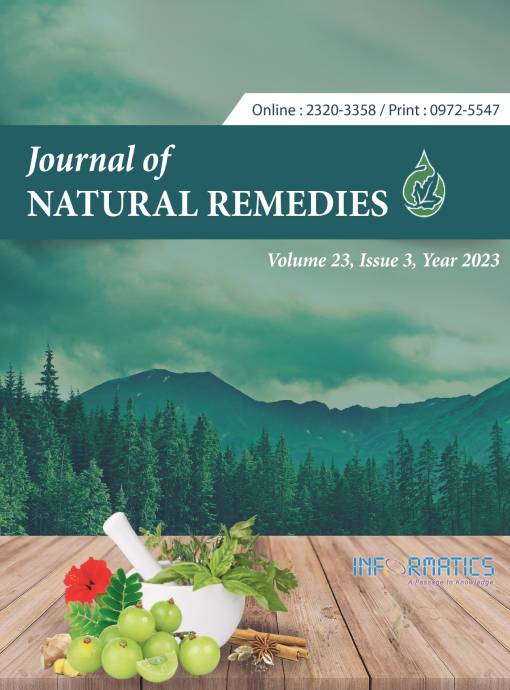Acute and Sub-acute Toxicity Studies of a Siddha Medicine Ganthaga Mezhugu by Oral Administration in Sprague Dawley Rats
DOI:
https://doi.org/10.18311/jnr/2023/31703Keywords:
OECD, Sulphur, Toxicity, Traditional MedicineAbstract
Psoriasis, a chronic auto-immune skin disease, is troubling 1-3 % of the world population with a 0.44-2.8% prevalence rate in India affecting more males than females. It is considered a dermatologist’s menace as it is challenging to treat the condition. Siddha, one of the traditional systems of medicine practised more in South India, includes a wide range of medicines that are used to treat or manage various ailments, including psoriasis. One such medicine is Ganthaga Mezhugu (GM) used in treating skin diseases like psoriasis. This present study deals with the evaluation of the safety of GM as per the Organization for Economic Co-operation and Development (OECD) Guidelines 423 and 407 in Sprague Dawley (SD) rats. In the Acute Toxicity study, SD female rats were grouped into five, in which Groups I and II received elemental Sulphur in two different doses, Groups III and IV received Sulphur ‘purified’ with two different Siddha processes and Group V received GM (2000mg/kg b.wt.). In the subacute toxicity study, SD rats of both sexes were grouped into six in which Group 1 served as vehicle control, Groups 2, 3, and 4 as low, mid, and high dose groups and the last two (Groups 5 and 6) as satellite control and satellite high-dose groups. In the acute study, no mortality, toxic signs or any gross pathological changes were noted. Hence, the LD50 value of GM was found to be greater than 2000mg/kg b.wt. In the sub-acute toxicity study, no mortality or morbidity occurred. There was a gradual increase in body weight with normal food and water intake indicating normalcy in its metabolism. There were no significant changes in hematological and biochemical parameters, serum electrolytes and gross pathology. Also, no pathological changes were found in the histopathology of organs in treated animals when compared with control group animals. Based on the results, regarding the Globally Harmonized System of Classification and Labelling of chemicals, GM can be classified as Category−5, which implies its safety for human consumption. Moreover, the results of the sub-acute study also confirm the safety of GM up to the dose of 400mg/kg b.wt.
Downloads
Metrics
Downloads
Published
How to Cite
Issue
Section
License
Copyright (c) 2022 G. J. Christian, P. Shanmugapriya, S. Elansekaran, T. Subathra, R. Meenakumari (Author)

This work is licensed under a Creative Commons Attribution 4.0 International License.
Accepted 2023-05-25
Published 2023-07-03
References
Thiyagarajan R. Siddha Maruthuvam Sirappu. Commissionerate of Indian Medicine and Homeopathy: Chennai; 2013. p. 276.
Mok CF, Xie CM, Sham KW, Lin ZX, Cheng CH. 1,4-dihydroxy-2-naphthoic acid induces apoptosis in human keratinocyte: Potential application for psoriasis treatment. Evid Based Complement Alternat Med. 2013. https://pubmed.ncbi.nlm.nih.gov/23690852/ PMID: 23690852; PMCID: PMC3638593. https://doi. org/10.1155/2013/792840 DOI: https://doi.org/10.1155/2013/792840
Thappa DM, Munisamy M. Research on psoriasis in India: Where do we stand?. Indian J Med Res. 2017; 146(2):147-9. PMID: 29265013; PMCID: PMC5761022. https://doi.org/10.4103/ijmr.IJMR_ 1296_17 DOI: https://doi.org/10.4103/ijmr.IJMR_1296_17
Muthaliyar KNK, Uthamarayan CS. Siddha Vaidya Thirattu. 2nd ed. Indian System of Medicine and Homeopathy; p. 200.
Thiyagarajan R. Gunapadam Thathu Jeeva Vaguppu. 4th ed. Tamilnadu Siddha Medical Council; 1992. 6. OECD Test No. 423: Acute oral toxicity - Acute Toxic Class Method, OECD Guidelines for the testing of chemicals, Secs. 4, OECD Publishing, Paris; 2002. https://doi.org/10.1787/9789264071001-en DOI: https://doi.org/10.1787/9789264071001-en
Anonymous. Understanding the Globally Harmonized System of classification and labelling of chemicals – A companion guide to the GHS Purple Book. 4th ed. Switzerland; 2012.
OECD Test No. 407: Repeated dose 28 day oral toxicity study in rodents, OECD guidelines for the testing of chemicals, Secs. 4, OECD Publishing, Paris; 2008. https://doi.org/10.1787/9789264070684-en DOI: https://doi.org/10.1787/9789264070684-en
Petterino C, Argentino-Storino A. Clinical chemistry and haematology historical data in control Sprague– Dawley rats from pre-clinical toxicity studies. Exp Toxicol Pathol. 2006; 57:213-19. https://doi. org/10.1016/j.etp.2005.10.002
World Health Organization. 2014–2023 Traditional Medicine Strategy. Geneva, Switzerland [Internet]. 2014. Available from: https://www.who.int/ publications/i/item/9789241506096
Mukinda JT, Syce JA. Acute and chronic toxicity of the aqueous extract of Artemisia afra in rodents. J Ethnopharmacol. 2007; 112:138-44. https://doi. org/10.1016/j.jep.2007.02.011 DOI: https://doi.org/10.1016/j.jep.2007.02.011
Petterino C, Argentino-Storino A. Clinical chemistry and haematology historical data in control Sprague– Dawley rats from pre-clinical toxicity studies. Exp Toxicol Pathol. 2006; 57:213-19. https://doi. org/10.1016/j.etp.2005.10.002 DOI: https://doi.org/10.1016/j.etp.2005.10.002
Adeneyea AA, Ajagbonnab OP, Adelekec TI, Bellod SO. Preliminary toxicity and phytochemical studies of the stem bark aqueous extract of Musanga cecropioides in rats. J Ethnopharmacol. 2006; 105:374-9. https:// doi.org/10.1016/j.jep.2005.11.027 DOI: https://doi.org/10.1016/j.jep.2005.11.027
Hilaly JE, Israili ZH, Lyouss B. Acute and chronic toxicological studies of Ajuva Iva in experimental animals. J Ethnopharmacol. 2004; 91:43-50. https://doi.org/10.1016/j.jep.2003.11.009 DOI: https://doi.org/10.1016/j.jep.2003.11.009
Moriles KE, Azer SA. Alanine amino transferase [Internet]. 2022. StatPearls. Treasure Island (FL): StatPearls Publishing; 2022. Available from: https://www.ncbi.nlm.nih.gov/books/NBK559278/

 G. J. Christian
G. J. Christian









 0.35
0.35 24
24 0.161
0.161